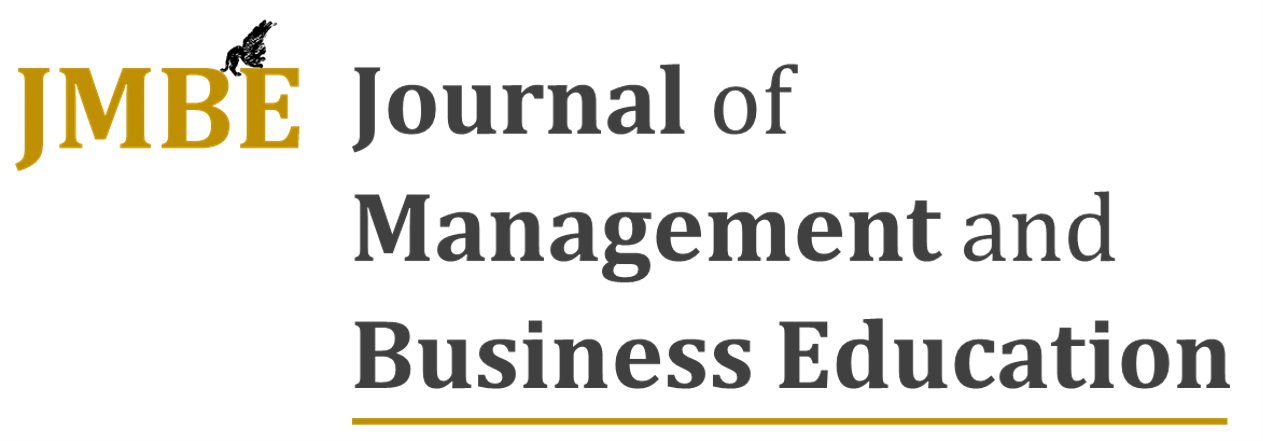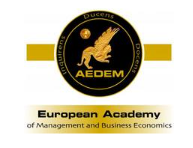Teaching experience in the social media manager course in a situation of confinement by covid-19
DOI:
https://doi.org/10.35564/jmbe.2021.0019Keywords:
e-learning, COVID-19, Internet, consumer behaviorAbstract
In the year 2020 we live the irruption of an unknown virus that caused our life habits to change. The various means through which a consumer can connect to the Internet took on greater importance, increasing the daily use of smartphones and personal computers. E-learning or virtual teaching became the only option to continue training from home. The strict confinement that was established, due to COVID-19, closed all the centers considered non-essential, such as schools, institutes or universities. The increase in students in this type of education in recent years was already a fact, since one of the main problems of traditional education, geographic distance, was eliminated. The objective of the research is based on demonstrating, through experience in the Social Media Manager course, that in the face of the COVID-19 situation, online training, e-learning or virtual teaching facilitated the ability to continue training at people from home and that a high percentage completed the course satisfactorily. For this, we present the theoretical framework where e-learning is located, as well as the experience in virtual teaching in the Continuing Training Course "Social Media Manager", which was taught entirely online through the Virtual Classroom of the university in a situation of total confinement due to the COVID-19 virus. And although some studies indicate that there is low motivation and a high degree of abandonment in this type of study, in our case the results show that 82.5% did it satisfactorily with an “Apt” grade, and only there was one student (2.5%) who did not get to carry out any activity of the course. Research shows us that with optimal resources and good management, positive results can be achieved.
Downloads
References
Adell, J. (1997). Tendencias en educación en la sociedad de las tecnologías de la información. Revista electrónica de tecnología educativa, 7. https://doi.org/10.21556/edutec.1997.7.570
Alcantud, F. (1999). Teleformación: diseño para todos. University of Valencia Publications Service, Valencia.
Almaiah, M.A., Al-Khasawneh, A. y Althunibat, A. (2020). Exploring the critical challenges and factors influencing the E-learning system usage during COVID-19 pandemic. Education and Information Technologies, 25, 5261-5280. https://doi.org/10.1007/s10639-020-10219-y
Almonte, M.G. y Bravo, J. (2016). Gamificación y e-learning: estudio de un contexto universitario para la adecuación de su diseño. Tecnología, Ciencia y Educación, mayo-agosto, 52-60. https://doi.org/10.51302/tce.2016.78
Barro, S. y Murillo, P. (2006). Las TIC en el Sistema Universitario Español. Conferencia de Rectores de las Universidades Españolas, Madrid.
Benito, D. (2009). Las estrategias de aprendizaje en el entorno e-learning. IV Jornada de Innovación Pedagógica del Proyecto ADA-Madrid, Madrid.
Bhattacherjee, A. (2001). Understanding information systems continuance: an expectation-confirmation model. MIS Quarterly, 25(3), 351-370. https://doi.org/10.2307/3250921
Bigné, E., Badenes, A., Ruiz, C. y Andreu, L. (2018). Virtual classroom: teacher skills to promote student engagement. Journal of Management and Business Education, 1(2), 87-105. https://doi.org/10.35564/jmbe.2018.0008
Cabero, J. (2007). Las necesidades de las TICs en el ámbito educativo: riesgos y oportunidades. Revista Tecnología y Comunicación Educativas, 4, 19.
Cabero, J. y Gisbert, M. (2005). Formación en Internet. Guía para el diseño de materiales didácticos, MAD, Sevilla.
Cortizo, J.C., Carrero, F. M., Monsalve, B., Velasco, A., Díaz, L.I. y Pérez-Martín, J. (2011). Gamificación y Docencia: Lo que la Universidad tiene que aprender de los Videojuegos. Universidad Europea de Madrid, Madrid. Accesible en http://hdl.handle.net/11268/1750
Del Moral, M.E. (2014). Advergames & Edutainment: Fórmulas creativas para aprender jugando. En Revuelta, F., Fernández, M.R., Pedrera, M.I. & Valverde, J. (coords.). II Congreso Internacional de Videojuegos y Educación (CIVE 2013), 1-3 de octubre 2013, 13-24. Cáceres: Universidad de Extremadura. Accesible en https://dl.dropboxusercontent.com/u/4318784/Libro_CIVE_13.pdf
Duart, J.M. (2001a). Avaluació de la qualitat docent en entorns virtuals d’aprenentatge. Universitat Oberta de Catalunya (UOC), Barcelona. [Fecha consulta: 20 de noviembre de 2020]. Disponible en: https://www.uoc.edu/web/cat/art/uoc/0109041/duartmartin_imp.html
El‐Sayed Ebaid, I. (2020). Accounting students' perceptions on e-learning during the Covid-19 pandemic: preliminary evidence from Saudi Arabia. Journal of Management and Business Education, 3(3), 236-249. https://doi.org/10.35564/jmbe.2020.0015
Fundación para el Desarrollo de la Función Social de las Comunicaciones (1998). Teleformación. Un paso más en el camino de la Formación Continua. FUNDESCO, Madrid.
Gallego, A. y Martínez, E. (2003). Estilos de aprendizaje y e-learning. Hacia un mayor rendimiento académico. Revista de Educación a Distancia, 7. Recuperado a partir de https://revistas.um.es/red/article/view/25411
García, E. (2007). El “abandono” en cursos de e-learning: algunos aprendizajes para nuevas propuestas. Revista Iberoamericana de Educación, 44, 3. https://doi.org/10.35362/rie4432241
García, L. (2001). La educación a distancia. De la teoría a la práctica. Editorial Ariel Educación, Barcelona. Disponible en https://revistas.usal.es/index.php/eks/article/view/14175/14582
Innovative Learning Technologies (2011). Formación eLearning: ventajas e inconvenientes. [Fecha de consulta: 02 de febrero 2019]. Disponible en: http://elearningeuropa.info/en/article/Formaci%C3%B3n-eLearning%3A-ventajas-e-inconvenientes
Instituto Nacional de Estadística (2011). Encuesta de Empleo del Tiempo 2009-2010. Notas de Prensa del INE, 14 de julio de 2011. [Fecha de consulta: 01 de marzo 2021]. Disponible en: http://www.ine.es/prensa/np669.pdf
Instituto Nacional de Estadística (INE) (2020). Encuesta sobre Equipamiento y Uso de Tecnologías de Información y Comunicación en los Hogares 2020, 16 de noviembre de 2020. [Fecha de consulta: 01 de marzo 2021]. Disponible en: https://www.ine.es/prensa/tich_2020.pdf
Jiménez, N.; San-Martín, S.; Rodríguez-Torrico, P.; y Jerónimo Sánchez-Beato, E. (2019). The most waited engagement in higher education: teachers and students’ committed with e-learning. Journal of Management and Business Education, 2(3), 232-249. https://doi.org/10.35564/jmbe.2019.0016
Lee, J.J. y Hammer, J. (2011). Gamification in education: What, how, why bother?. Academic Exchange Quarterly, 15(2), 146.
Marcelo, C. y Lavié, J.M. (2000). Formación y Nuevas Tecnologías: Posibilidades y condiciones de la teleformación como espacio de aprendizaje. Bordón, 52(3), 385-406.
McIsaac, M.S. y Gunawardena, C.N. (1996). Distance Education. En Jonassen. D.H. (1996), Handbook on Research for Educational Communications and Technology, McMillan, Nueva York, 403-437.
Pallof, R. y Pratt, K. (2003). The virtual student: a profile and guide to working with online learners. San Francisco, Jossey Bass Wiley.
Pérez, A. y Blasco, P. (2009). Metodología de Estudio en los Programas de Formación a Distancia. Alfa Delta Digital, Valencia.
Rosenberg, M. (2001). E-learning: Strategies for Delivering Knowledge in the Digital Age. McGraw Hill, Nueva York.
Rubio, M. J. (2003). Enfoques y modelos de evaluación del e-learning. Revista Electrónica de Investigación y Evaluación Educativa (RELIEVE), 9(2), 101-120. Disponible en: https://www.fceia.unr.edu.ar/geii/maestria/2013/Dra.Roig/U3%20Rubio_ev_educacion_virtual.pdf
Schneckenberg, D. (2004). El e-learning transforma la educación superior. Educar (en línea), 33, 143-156. Disponible en: https://raco.cat/index.php/Educar/article/view/20793
Tiffin, J. y Rajasingham, L. (1997). En busca de la clase virtual. La educación en la sociedad de la información. Editorial Paidós, Barcelona.
United Nations Educational, Scientific and Cultural Organization (2002). Open and distance learning: trends, policy and strategy considerations. UNESCO, París. Disponible en: https://www.saide.org.za/resources/Library/Moore%20-%20UNESCO%20ODL%20trends%20policy%20and%20strategy%20.pdf
Downloads
Published
How to Cite
Issue
Section
License
Copyright (c) 2023 Journal of Management and Business Education

This work is licensed under a Creative Commons Attribution-NonCommercial-ShareAlike 4.0 International License.
License terms at: https://creativecommons.org/licenses/by-nc/4.0/legalcode




